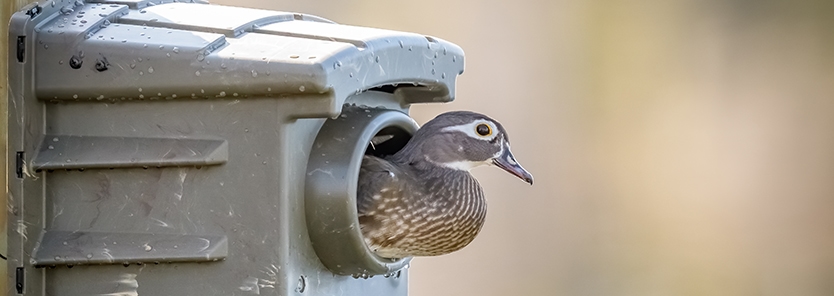Wood Duck Box Maintenance
With the increase of urbanization and short-term timber harvesting, wood duck nesting habitat is decreasing. Most timber-stands are currently managed for the quickest return possible. Therefore, old-growth mature hardwoods, which provided cavities for nesting, are decreasing. So what can we do about this decline? First, install a wood duck box or boxes. Then, make sure to maintain them.
These beautiful ducks traditionally have nested in old-growth hardwood cavities found in, or near wetland environments. However, we can assist them with a “well-designed duck box” like the ones offered by Duck Hut – you can help nature and make your hunting better. It’s imperative that you clean them out annually and refresh the nesting material. Once you start you must continue on and every few years expand and add a few new boxes. If you notice that one location, for some reason, doesn’t get used…move it.
One of the first tasks for a gamekeeper after duck season is to clean out these duck boxes and replace the old shavings with new. Remove the eggshells and membranes from last season and replace or add new wood shavings to a depth of 4 or 5 inches. Cedar shavings are easy to find, they are not very expensive and one twenty pound bag will freshen approximately15 boxes.
While it’s still cold, it’s safe to reach inside to clean out the boxes – which can be home to giant wasp nests and even the occasional egg eating snake (if you don’t have predator guards). So the earlier you do this, or the colder it is when you do this, the better. One trick I’ve learned is to stick my cell phone camera in and take a picture before reaching into the unknown.
A proper box provides cover to ensure shelter and protection for eggs/ducklings when they are most vulnerable. How-ever, simply nailing a wood duck box to any random tree near your pond may do more harm than good. Knowledge of nesting methods along with strategic placement and design of the box are imperative if you’re interested in seeing results from your labors – these layouts may require some thinking “outside the box.”
You must make it difficult for nest predators to access the box or you’re just “ringing the dinner bell” for raccoons, snakes, fishers, possums and other furry creatures. The Wood Duck Society suggests rather than placing boxes in trees, to instead, place them on posts and use a “galvanized steel cone” so predators cannot climb up the post.
Some like to hang their boxes high, thinking some predators can’t reach it, but that’s really not necessary and makes maintaining them more difficult for you. And most can still reach it better than you anyhow. In fact, some studies have shown they prefer lower-mounted boxes. This means no ladders or climbing, and boxes can be maintained with “your boots on terra firma.”
Wood ducks are a real conservation success story. At the turn of the century “woodies” were almost extinct. But today, through proper management the populations are higher than ever. In Mississippi, we were recently allowed to harvest three woodies per day. Who doesn’t love to hear them whistle through the decoys at day-light? The drake’s colorful plumage sparks conversation of awe and appreciation of nature.
Set up a few wood duck boxes when you can and plan ahead for next year. When a hen decides to call it home, it’ll make you proud.
~
For more from GameKeeper Farming For Wildlife, join our weekly newsletter or subscribe to GameKeepers Magazine. Your source for information, equipment, know-how, deals and discounts to help you get the most from every hard-earned moment in the field.








